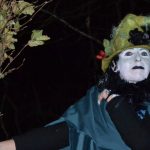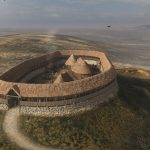The Cateran Ecomuseum recently celebrated its fourth birthday, and what an incredible four years it has been.
We launched on November 11, 2019 – the 100th anniversary of the birth of Hamish Henderson, the Scottish poet, activist, songwriter and collector of traditional folk songs who was born and spent the early years of his life in Glenshee and Blairgowrie.
The launch programme, ‘No Boundaries’, featured music, song and poetry set against the stunning backdrop of the snowy mountains of Glenshee, a spectacular portrait of Hamish on the hillside and a light and sound installation created by local young people and our Makar, Jim Mackintosh.

It was the culmination of two years of work, which sprang from an idea that first began to germinate in 2016 when one of our co-founders attended a conference on slow tourism.
Ecomuseums originated in France in the 1970s and are still a relatively new concept with around 1,000 worldwide and currently only one other in Scotland, on Skye.
Set in specific landscapes, they are community-led and managed, offer a more holistic nature and culture frame for the interpretation of heritage, and are a focus for tourism that prioritises community empowerment.
The Cateran Ecomuseum encompasses 1,000 square kilometres of the beautiful and dramatic landscapes of Eastern Perthshire and Western Angus, stretching into the Cairngorms National Park, and is designed to reveal the hidden heritage of this little-known part of Scotland by the community who live there.
It tells the story of the people, places and landscapes of the area across 8,000 years of human history and 400 million years of geological history, and, like many parts of Scotland, we have a treasure trove of natural and cultural heritage to draw on.
We have everything from huge prehistoric Megaliths and Pictish Symbol Stones to little-known stories from the great legends of King Arthur and the pan-Gaelic hero Finn mac Cumhaill.

Diarmuid’s Grave, Glenshee, photo by Clare Cooper
We have more contemporary histories of the Scottish Traveller community, fables of the Caterans themselves – Highland clan warriors who came to be associated with cattle raiding in the 17th and 18th centuries – and important events linked to the great Jacobite uprisings.
In the four years since we launched, we have put together 25 pre-designed itineraries aimed at attracting both local people and visitors and connecting folk to nearly 140 points of natural and cultural heritage interest – and we have only just started to scratch the surface of what we could share.
Although the global coronavirus pandemic affected our plans for 2020, we adapted, broadcasting an online programme through our social media platforms every day for the first 100 days of lockdown.
#Cateran100 saw 66 local, national and international poets, musicians, storytellers and film makers from Scotland, USA, Canada, Finland and Australia contribute their time and their talent voluntarily, creating a huge and diverse collection of sound, song, film and spoken word, all of which are still available online.
By January 2021 we had raised enough money to launch the first stage of a programme dedicated to climate action, the ‘Museum of Rapid Transition’, inspired by Andrew Simms of the Rapid Transition Alliance and the idea that our heritage has a huge, currently under-utilised potential to help people build more regenerative and resilient lifestyles and to mobilise climate action.
The first stage of the Museum of Rapid Transition story began that year with a focus on landscapes and involved a series of projects and activities that revealed how changes in geology and climate have shaped our landscapes, determined the flora and fauna, influenced human settlement, land-use, and social and political organisation and demonstrated both how our past actions have degraded these landscapes and how, by reconnecting to ancient knowledge, we can regenerate and innovate our relationship with it.

Our ‘Turning Points’ exhibition detailed 20,000 years of climate change in Tayside, and a symbolic ceremony, ‘The Awakening’, was held in Glenshee at a unique 9,000 sqm art installation timed to coincide with the UN Climate Change Conference, COP 26, which was held in Glasgow that year.
Our Travel For All Our Tomorrows initiative saw us develop a second stage of heritage-based walking and cycling itineraries across the Cateran Ecomuseum, promoting active travel for leisure and positioning us as one of Scotland’s premier car-free holiday destinations.

The following year saw Alyth Museum transformed into an orientation space for the Ecomuseum, working with Culture Perth and Kinross, and the start of the development of our School of the Moon, a community-led initiative that aims to offer an annual programme of intergenerational learning and activities within the landscapes of the Ecomuseum.
This year, in our biggest programme of events to date, we held 24 free led walks and guided cycling events, two self-guided cycling events, including the inaugural Cateran Dirt Dash, and a performance walk and an accompanying audio tour focusing on the cultural heritage of Meigle. We also launched a new film about regenerative tourism and the Cateran Ecomsueum, and a new booklet highlighting the walking itineraries developed in 2021 and four new audio guides.

A Spin Along the Ericht guided walk with local historian Meg Luckins. Image courtesy of Clare McMicking
Our River Detectives project – which involves around 30 volunteer community scientists working with leading environmental scientists and historians on the collection of new data on land management practices during the agricultural and industrial revolutions – is under way and already revealing some very exciting results.
And we’re working on plans for some great events next year, as well as new content for Alyth Museum, which are sure to be inspirational and informative – watch this space for more details!

The inaugural Cateran Dirt Dash. Image courtesy of Markus Stitz
Thanks to National Lottery Heritage Fund, Inspiring Scotland and the Scottish Government’s Rural and Island Communities Idea Into Action Fund, SSE Drumderg, the Perth and Kinross and Angus Leader programmes, Creative Scotland, Cairngorms National Park, Paths for All, Cairngorms National Park, NatureScot and Perth & Kinross Council, Gannochy Trust, Alyth Development Trust, NatureScot

